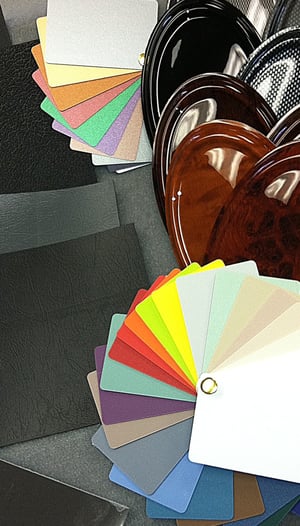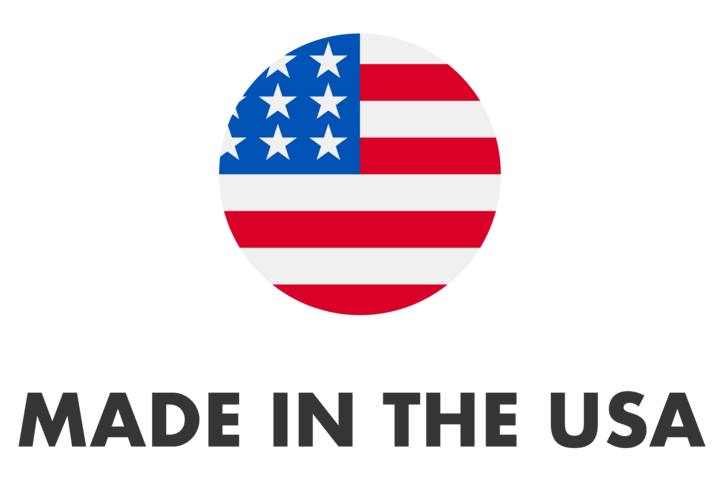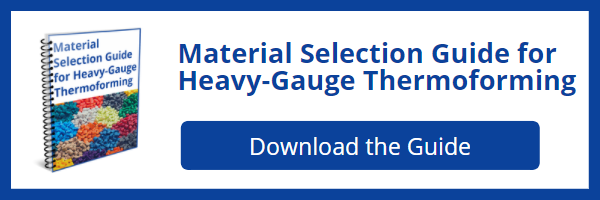Specialty Materials
Selecting the Right Material
Part design for thermoforming of a heavy gauge thermoplastic sheet, i.e., thicknesses of 0.0600 in./1.5 mm or greater, usually consists of several interrelated components or steps, including CAD modeling, material selection, tooling design and build, and prototyping.
Ideally, this should be a collaborative process drawing on the collective expertise of the thermoforming vendor, suppliers, and the customer.
Collaboration helps to anticipate any issues and ensure a smooth, cost-effective launch once the part goes into commercial production.
Choosing the right material is based on the project specifications, performance requirements, and manufacturability critical to project success.
Many factors go into selecting the ideal material for thermoforming parts.
Identifying the Material Properties
A myriad of material properties will guide the selection of a given material for a specific application.
The most critical of these are as follows:
- Strength and stiffness
- Impact resistance
- High-temperature resistance/application service temperature
- Weatherability
- Transparency/clarity
- Coloring
- Fire retardancy rating and certification
- Machinability and bonding characteristics
- Chemical resistance
- Anti-Graffiti
- Anti-Microbial
- Recyclable
- And, finally, cost
Specialty Materials Available
Polymer Selection
There are two general polymer types to consider:
Thermoplastic polymers consist of long chains of molecules and are classified as amorphous or crystalline.
Amorphous polymers
Amorphous polymers have a random molecular structure and do not exhibit a sharp, distinct melting point.
Instead, as the temperature rises above the glass transition temperature (Tg) these polymers become gradually softer and softer until they melt.
The glass transition temperature of amorphous polymers can be adjusted using chemical additives and fillers.
Potential Material Options
- ABS
- Acrylic
- Acrylic/PVC blends
- PPO/PS blend
- PETG Polycarbonate
- Polystyrene (HIPS)
- Polysulfone
- PVC
- Polyphenylsulfone
- Polyetherimide
GENERAL CHARACTERISTICS— AMORPHOUS THERMOPLASTICS
- Soften over a wide temperature range
- Good formability
- Transparency
- Poor chemical resistance
- Bond using adhesives or solvents
- Prone to stress cracking
- Poor fatigue resistance
- Structural applications only (not suitable for bearing and wear)
Semi-Crystalline Polymers
Crystalline and Semi-crystalline Polymers have a highly ordered molecular structure. The bulk polymer material does not gradually soften as the temperature increases but instead turns from solid to liquid at a defined melting temperature.
As more heat energy is applied to the material, the polymer chains gain enough energy to begin moving and sliding with respect to one another at an increasing rate. Melt is achieved when all polymer molecules are in motion. After melting, the polymer crystallizes again once it is cooled below the Tm.
Potential Material Options
- Acetal HDPE
- LDPE
- Nylon
- PBT
- PEEK
- PET
- Polypropylene
- PPS
- PTFE
- PVDF
- UHMW-PE
GENERAL CHARACTERISTICS—SEMI-CRYSTALLINE THERMOPLASTICS
- Sharp melting point
- Poor formability
- Opaque Good chemical resistance
- Difficult to bond using adhesives or solvents
- Resistant to stress cracking
- Good fatigue resistance
- Good for bearing and wear (as well as structural applications)
As with amorphous polymers, melting and other physical properties can be modified by the addition of chemical additives and plasticizers.
Common Materials Used in Thermoforming Operations
 Thermoforming accommodates a wide range of materials, varying in functional and aesthetic characteristics, to suit different part and production specifications. At Plastic Components, Inc., we utilize the following materials in our thermoforming operations:
Thermoforming accommodates a wide range of materials, varying in functional and aesthetic characteristics, to suit different part and production specifications. At Plastic Components, Inc., we utilize the following materials in our thermoforming operations:
- ABS
- Soft-touch ABS-backed vinyl
- Rubber
- Polystyrene
- Polyethylene
- Polypropylene
- PVC including Fire Rated, Low Smoke, and Low Tox
- PPO
- Polycarbonate
- Acrylic
- Thermoplastic Olefins
- Coextruded Materials
- Laminates over ABS/TPO
These materials are available in a variety of colors and textures.
Plastic Components, Inc. is a premier provider of quality thermoformed components for customers in a wide range of industries. In addition to our thermoforming capabilities, we also provide product design assistance and tooling design, engineering, and building services to help ensure customers receive product solutions that fully meet their needs. To learn more about our thermoforming capabilities or partner with us on your next project, get in touch with us below.

